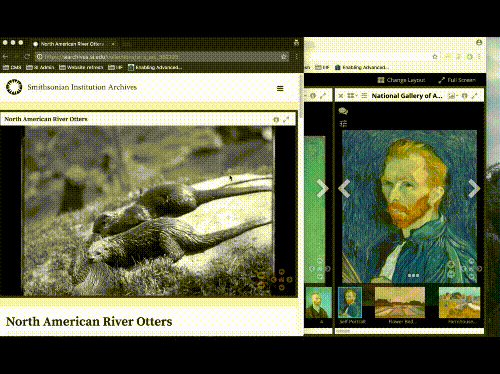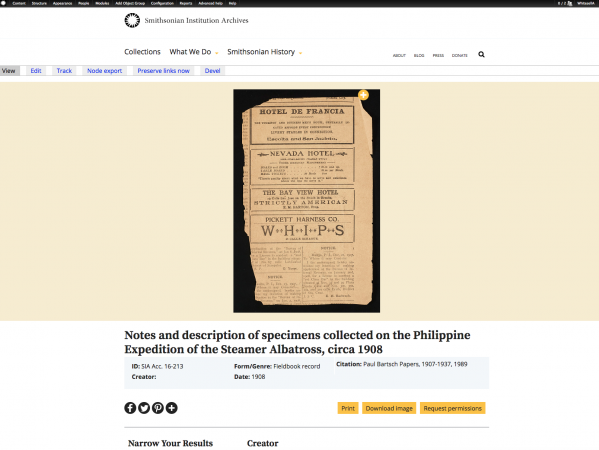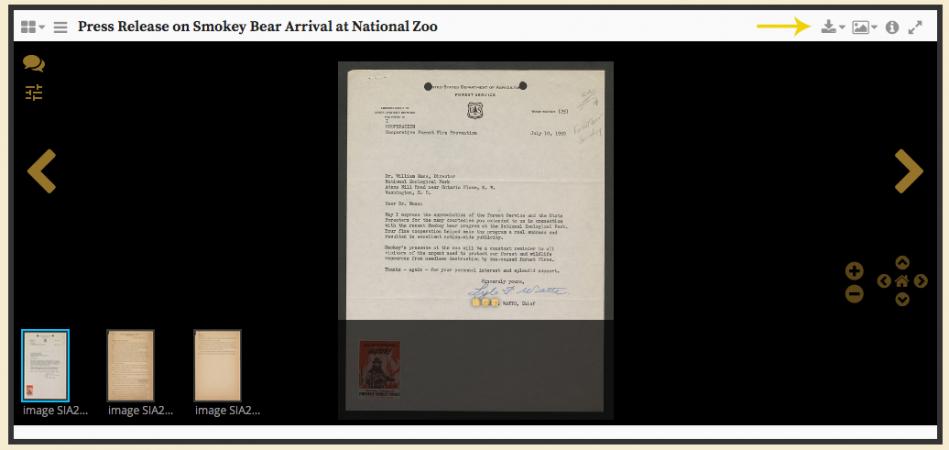About a year ago, I wrote a post to introduce our new collection viewer. Though the change was slightly inconspicuous, it actually pointed to a much bigger transition that was happening on our site. That shift began when the Archives adopted the International Image Interoperability Framework (IIIF, pronounced “triple-eye-eff”).
All of our single collection images now boasted their own IIIF manifest files. These manifest files, a JSON (JavaScript Object Notation) files that contain the structured metadata associated with a collection item and a link to a full-size image of the object. These manifest files can be loaded into and ready by any IIIF viewer in order to pull up and view that given collection item. That way, you could compare two IIIF-enabled items from different institutions. For example, I highlighted comparing a self-portrait of Vincent van Gogh from the Harvard Art Museums and a picture of an otter from our own collection.

I’m not sure why anyone would want to compare 19th-century post-impressionist painters with members of the weasel family, but you can. A more likely example would be comparing an engraving of James Smithson with a bust of James Smithson.

Since the roll out, IIIF has been spreading through our site. It’s even on our search result pages as thumbnails. Meanwhile, our multi-paged documents pages haven’t changed at all. They had not been IIIF enabled. Instead, all they featured was a thumbnail, a link off site.

Why no love for our multi-paged documents? The answer has to do with technical limitations that were present at the time. While our centralized image and metadata repositories did a great job at creating manifests for us, they couldn’t handle big multi-paged documents.
Luckily, due to requirements of the old system we used, we were generating xml files containing structural metadata. 2,000 of them, in fact. These files are a lot like the JSON files we need for IIIF, but they were just in a different format. A transform later, and those 2,000 xml files were converted into the IIIF friendly JSON files.
We still needed a place to put them.
As I’m writing a blog to introduce our first few multi-paged documents going out, you may have guessed that we figured that part out too. Now that we’ve managed to clear up those few technical hurdles, we’re slowly starting to push them out on our site (they do require a bit of manual labor to point our metadata services to the JSON files). The first few collections you’re likely going to notice them have to do with Smokey Bear.
https://siarchives.si.edu/collections/siris_sic_14926
https://siarchives.si.edu/collections/siris_sic_14927
https://siarchives.si.edu/collections/siris_sic_14925
https://siarchives.si.edu/collections/siris_sic_14917
If you play around with those collections (actually, any of our IIIF collections) and you have a really keen eye, you may have noticed a slight change to our viewer. Specifically, in the tool bar.

Our viewer now has a download button on it. That button will give you two options. One, you can grab the manifest file for that collection so you can pull it into another IIIF viewer. The other option is to download a copy of the image you are currently viewing.
Eventually we will get all of our 2,000 multi-paged collections hooked up to our new viewer. But, in the meantime, feel free to check out the cool collections of Smokey Bear. It’s a great way to kick off his 75th anniversary.
Related Resources
- "Some IIIF-y Collections," by Andrew Whitesell, The Bigger Picture, Smithsonian Institution Archives
- "Some Web Developer Career Advice," by Andrew Whitesell," The Bigger Picture, Smithsonian Institution Archives
- "The Search Server is Dead, Long Live the Search Server.," by Andrew Whitesell, The Bigger Picture, Smithsonian Institution Archives
Produced by the Smithsonian Institution Archives. For copyright questions, please see the Terms of Use.

Leave a Comment